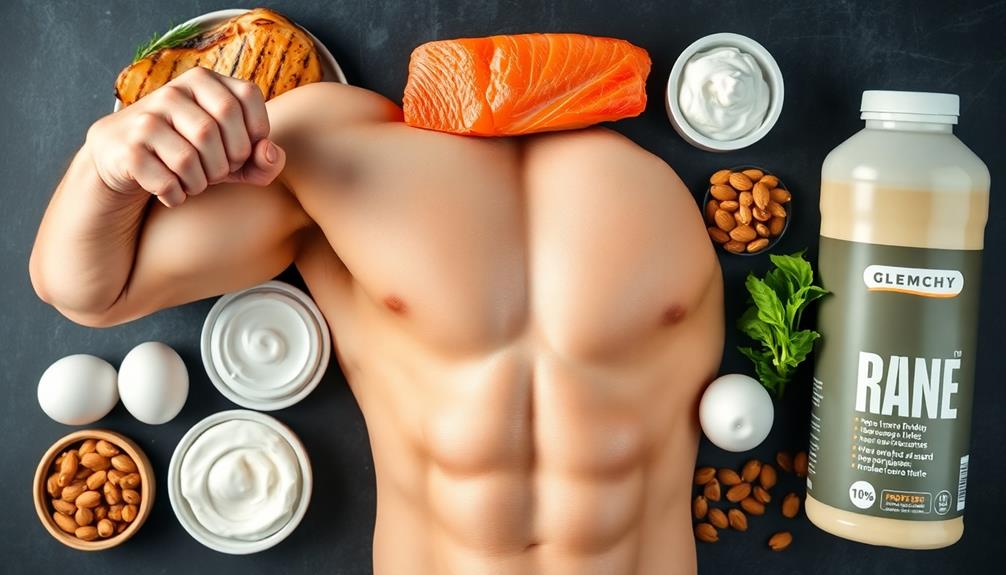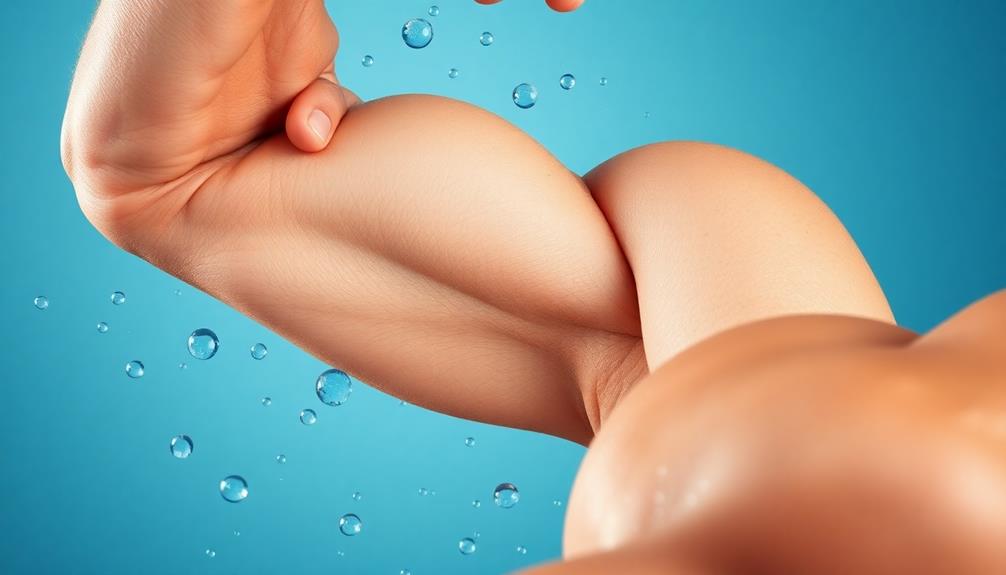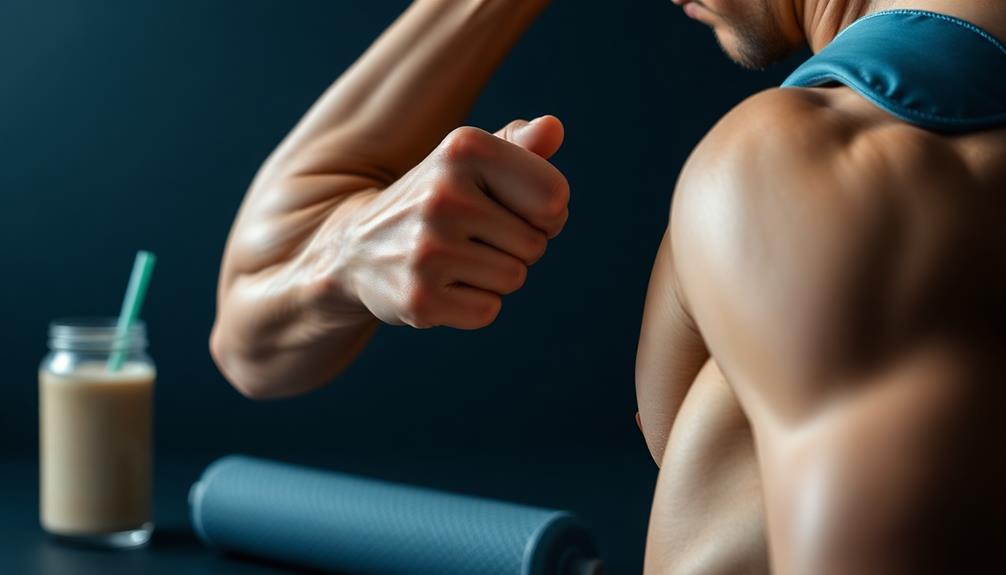To enhance muscle repair and growth after hypertrophy workouts, focus on these key steps: Consume protein-rich foods, aiming for 1.6-2.2 grams per kilogram of body weight daily. Stay properly hydrated before, during, and after exercise. Get 7-9 hours of quality sleep each night. Stretch and cool down post-workout to prevent soreness. Use foam rollers for muscle relaxation and improved blood flow. Manage stress levels, supplement wisely, and maintain proper nutrition. Incorporate active recovery techniques into your routine. By following these steps, you'll support excellent muscle recovery and growth. Discover more detailed strategies to enhance your post-workout recovery process.
Core Insight
- Consume protein-rich foods, aiming for 1.6-2.2 grams per kilogram of body weight daily, distributed across meals.
- Stay properly hydrated before, during, and after exercise to support nutrient transport and waste elimination.
- Get 7-9 hours of quality sleep nightly to promote muscle repair and growth hormone production.
- Perform gentle stretches and use foam rollers post-workout to prevent soreness and aid muscle recovery.
- Incorporate a proper cool-down routine, including stretching and hydration, to flush out waste and relax muscles.
Consume Protein-Rich Foods

Eating foods high in protein is crucial for repairing and growing muscle after tough weightlifting sessions. Protein gives your body the amino acids it needs to fix and build muscle. Aim for 1.6-2.2 grams of protein per kilogram of body weight each day. Protein powders are a convenient way to boost your protein intake, with 20-30 grams per scoop. Many also contain helpful extras like BCAAs and creatine.
Choose high-quality proteins such as lean meats, fish, eggs, dairy, beans, and tofu. Spread your protein intake evenly across your meals and have a serving within a half hour after training. This kick-starts recovery.
Protein shakes and bars are handy, especially when you're busy. But most of your protein should come from whole foods. Be consistent with your protein intake for the best muscle gains.
Hydrate Properly

Drinking enough water is key for muscle recovery and growth. Water moves nutrients to your muscles, gets rid of waste, and helps you perform your best. Drink water before, during, and after exercise to stay hydrated.
Follow this guide:
| Time | Amount |
|---|---|
| 2-3 hours before exercise | 16-20 oz (500-600 ml) |
| 15 min before exercise | 8-10 oz (250-300 ml) |
| During exercise | 7-10 oz (200-300 ml) every 15-20 min |
| After exercise | 16-24 oz (500-700 ml) per pound lost |
Get Adequate Sleep

Getting enough sleep is crucial for building muscle after strength training workouts. While you sleep, your body produces growth hormone, which helps repair and grow your muscles. Aim to get 7-9 hours of good quality sleep every night. You can use natural sleep aids like melatonin or herbal tea to help you sleep better without any harsh side effects.
To sleep better, try to go to bed at the same time each night. Make your bedroom dark, quiet, and cool. Don't use your phone, tablet, or computer for at least an hour before bed, as the blue light can make it harder to fall asleep. If you can't fall asleep easily, try deep breathing or meditation to relax.
Stretch and Cool Down

After an intense workout and a good night's sleep, it's important to stretch and cool down. This helps prevent soreness and helps your muscles recover. Start with gentle stretches for the muscles you worked. Hold each stretch for 15-30 seconds while breathing deeply. A foam roller can also help by giving your muscles a deep tissue massage.
Next, use foam rolling or self-massage to release tension in your muscles. This improves blood flow and lowers your risk of injury. And don't forget to drink water during this process. It helps flush out waste from your muscles.
Use Foam Rollers

Foam rollers are great tools to help you recover after a workout. They release tension in your muscles, boost blood flow, and ease soreness. Choose a foam roller based on your experience level – softer for beginners, firmer for more advanced users. High-density rollers provide deep tissue massage and target specific muscles. Textured rollers mimic the feeling of a massage therapist's hands.
Start by rolling larger muscles like your back, glutes, and thighs. Move slowly, pausing on tight spots for 20-30 seconds. Use steady pressure without causing pain. Make long, smooth strokes along the muscle fibers.
For the best results, use your foam roller right after your workout and before bed. Spend 5-10 minutes on the muscles you worked that day. Stay hydrated and breathe evenly while rolling. Combined with good nutrition and rest, foam rolling will help repair and grow your muscles.
Take an Ice Bath

Taking an ice bath after a hard workout can help your whole body recover. Fill your tub with cold water and ice, so the water is between 50-59°F (10-15°C). Get in the tub and stay there for 10-15 minutes, but no more than 20 minutes. Special ice bath equipment can keep the water at the right temperature and make it more comfortable.
Ice baths reduce swelling, ease sore muscles, and speed up recovery. The cold makes your blood vessels smaller, which helps get rid of waste. When you get out, blood flow increases, bringing oxygen and nutrients to your muscles.
If you've never taken an ice bath before, start with less time and slowly work up to more. Pay attention to how your body feels, and talk to your doctor before making ice baths part of your recovery plan.
Manage Stress Levels

Stress can silently sabotage your muscle repair and growth. When stressed, your body releases cortisol, which interferes with muscle recovery and protein synthesis. To manage stress, try relaxation techniques like meditation, deep breathing, or yoga. These calm your mind and reduce cortisol. Using calming essential oil scents, such as lavender or chamomile, can further reduce stress.
Prioritize getting 7-9 hours of sleep per night for optimal muscle repair and well-being. Stick to a consistent sleep schedule and relaxing bedtime routine. Limit caffeine intake, especially later in the day.
Balance your workouts with enjoyable activities to prevent burnout. Recovery is both physical and mental. Managing stress effectively creates the ideal environment for muscle repair and growth.
Supplement Wisely

Supplements can support muscle growth and recovery, but they aren't magic. Focus on supplements proven to help build muscle. Here's a simple guide:
Whey protein helps your body build muscle fast. Take 20-30 grams after your workout.
Creatine boosts strength and muscle size. Take 5 grams per day.
BCAAs reduce soreness. Take 5-10 grams while working out.
Beta-alanine improves endurance. Take 2-5 grams daily.
Maintain Proper Nutrition

Eating right is key for repairing and building muscle. Focus on a balanced mix of protein, carbs, and healthy fats. Protein rebuilds muscle, carbs give you energy, and healthy fats support your hormones. Fitness apps may collect data about what you eat. Check their privacy policies to see how they use this info.
Aim for these amounts each day:
- 1.6-2.2 grams of protein per kilogram of body weight
- 3-5 grams of carbs per kilogram of body weight (mostly whole grains and veggies)
- Healthy fats from nuts, avocados, and fatty fish
Drink plenty of water to transport nutrients and keep muscles working well. Try to time your meals around workouts to absorb nutrients better and help muscles recover. Stick with your nutrition plan over the long haul for the best muscle growth and repair.
Active Recovery Techniques

Active recovery is important for muscle repair and growth after tough workouts. You should use these methods to recover better and get the most gains. Try doing these things:
- Light cardio: Improves blood flow
- Yoga: Makes you more flexible
- Foam rolling: Loosens tight muscles
- Swimming: Easy on your body but works everything
These techniques help you feel less sore, move better, and recover faster. Light cardio, like walking or biking, gets your blood moving and brings nutrients to your muscles. Yoga helps you stretch and relax your mind. Foam rolling targets specific muscles to relieve tightness and improve range of motion. Swimming is a low-impact way to stay in shape without putting too much stress on your muscles.
Frequently Asked Questions
How Long Should I Wait Between Hypertrophy Workouts for Optimal Muscle Growth?
You should usually wait 48-72 hours between hypertrophy workouts for best muscle growth. This allows your muscles to recover and rebuild. However, you can train different muscle groups on consecutive days if needed.
Can I Build Muscle Effectively With Bodyweight Exercises Alone?
Yes, you can build muscle effectively with bodyweight exercises alone. You'll need to focus on progressive overload, increase repetitions, and incorporate challenging variations. Consistency is key. With proper nutrition and rest, you'll see significant muscle gains over time.
What's the Ideal Rep Range for Hypertrophy Training?
You'll generally achieve peak hypertrophy in the 6-12 rep range. However, don't limit yourself; incorporate a mix of rep ranges in your training. Vary your workouts to target different muscle fibers and stimulate growth effectively.
How Do Hormones Affect Muscle Repair and Growth After Hypertrophy Workouts?
Hormones play a vital role in your muscle repair and growth. They'll boost protein synthesis, increase muscle cell size, and enhance nutrient uptake. Key hormones like testosterone, growth hormone, and insulin-like growth factor-1 are especially important for these processes.
Is It Necessary to Feel Sore After a Workout for Muscle Growth?
No, you don't need to feel sore for muscle growth. While soreness can indicate muscle damage, it's not a reliable measure of workout effectiveness. Focus on progressive overload and proper nutrition for best muscle growth, regardless of soreness.

